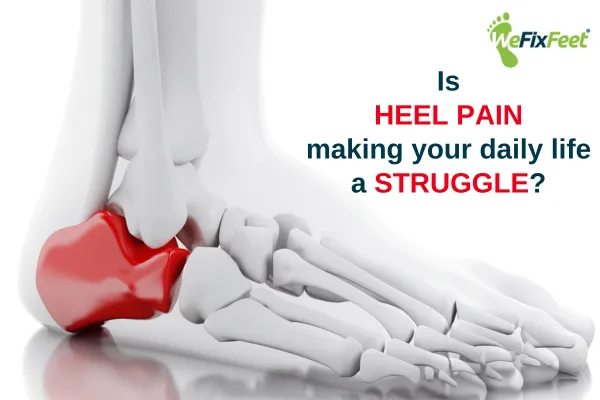
Why Does My Heel Hurt? What Can It Be?
Heel pain can enter your life, disrupting your plans and routine. For Ben, a 30-year-old professional and avid runner - it started as a mild discomfort during his morning workout. Before long, it became the pain that made standing at his desk feel like a chore. Like many, Ben wondered: “Why does my heel hurt, and what can I do about it?”
If this sounds familiar, you’re not alone. Heel pain is one of the most common complaints and can stem from several underlying causes. The good news? With the right approach, you can regain control and return to doing what you enjoy.
What Causes Heel Pain?
Heel pain can come from various sources, and understanding its cause is key to finding relief. Here are some common culprits:
Plantar Fasciitis occurs when the band of tissue supporting your foot's arch - the plantar fascia - becomes inflamed. It’s often triggered by overuse, unsupportive footwear, or sudden changes in activity levels.
Achilles Tendinitis: If the back of your heel feels stiff or painful, repetitive strain on the Achilles tendon might cause inflammation and longer-term problems.
Heel Spurs: These common bony growths develop over time, often alongside plantar fasciitis, adding to the discomfort.
Stress Fractures: Tiny cracks in the heel bone, caused by high-impact activities or overtraining, can lead to persistent pain.
Bursitis: Inflammation of the fluid-filled sacs in the heel area can cause swelling and tenderness.
How Can You Treat Heel Pain Effectively?
Ben’s story is a familiar one—after trying to ignore the pain and pushing through his workouts, he found himself unable to enjoy running or socialising without discomfort. The key to recovery isn’t just masking the symptoms; it’s addressing the root cause. Here’s how:
1. Start with a Biomechanical Assessment
Understanding how your body moves is crucial. A biomechanical assessment can uncover issues like poor posture or uneven gait that might contribute to nerve entrapment or undue stresses on muscles, tendons and ligaments - leading to heel pain. For Ben, this was the first step in identifying the strain caused by his running form.
2. Consider Custom Orthotics
Custom orthotics are more than just insoles—they’re tailored to provide functional support to your foot’s unique structure. By redistributing forces and aligning your feet properly, orthotics can help reduce pain and prevent future problems.
3. Explore Shockwave Therapy
Focussed Shockwave therapy is a game-changer for many. By using high-energy sound waves, this treatment stimulates healing in the affected area, reduces inflammation, and improves blood flow. Chronic conditions like plantar fasciitis can provide significant relief.
4. Strengthening and Rehabilitation
Recovery isn’t just about treatment—it’s about building resilience. Exercises that strengthen your feet and leg muscles can improve stability and reduce the likelihood of recurring pain. A well-structured rehab plan can be tailored to fit your lifestyle.
5. Hands-On Therapies
Sports massage and muscle energy techniques can ease tension, improve circulation, and promote healing. These therapies are beneficial if your heel pain stems from overuse or tight muscles.
Why Addressing Heel Pain Matters
Heel pain isn’t just a physical issue—it can ripple into other areas of your life. Ben found it hard to focus at work with the nagging discomfort. Skipping workouts left him less energised, and he worried about losing the fitness progress he’d worked so hard to achieve.
By addressing the pain early, you can avoid these frustrations and get back to enjoying your daily life.
Relief is possible - whether it’s running, gym sessions, or simply walking without wincing.
Practical Tips for Managing Heel Pain at Home
Stretch Regularly: Focus on your calves and the arches of your feet. Simple stretches can make a big difference.
Choose Supportive Footwear: Shoes with good arch support and cushioning can help alleviate heel pressure.
Rest and Ice: in the early stages after injury, If the pain is severe, give your feet a break and apply ice packs to reduce inflammation.
Strengthen Your Feet: Incorporate exercises like toe curls and heel raises to build strength and flexibility.
Your Next Steps
Heel pain doesn’t have to control your life. Like Ben, you can find relief with the right combination of care and commitment. Start by identifying the cause and taking practical steps towards recovery.
If you’re struggling with heel pain and want expert guidance, contact a podiatrist who can help tailor a recovery plan that works for you. Whether it’s a biomechanical assessment, shockwave therapy, or rehabilitation, your path to regaining your life pain-free is within reach.
Ask The We Fix Feet Team
Fill in the form to request a Call From Our Team
One of our team will call you for FREE and answer any questions or concerns you may have about your uncomfortable foot condition

Where To Find We Fix Feet
Our We Fix Feet podiatry clinics are conveniently located in Ilkeston, Derbyshire and Beeston, Nottinghamshire
Open: Mon-Fri 09:00-17:00 / Sat 09:00-13:00
94 Bath Street, Ilkeston, Derbyshire DE7 8FE
8 Wollaton Road, Beeston, Nottinghamshire NG9 2NR
Pay and display parking nearby



